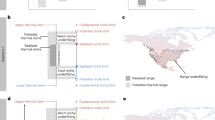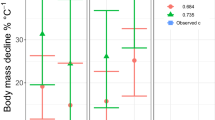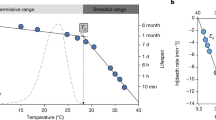Abstract
Understanding how climate change affects natural populations remains one of the greatest challenges for ecology and management of natural resources. Animals can remodel their physiology to compensate for the effects of temperature variation, and this physiological plasticity, or acclimation, can confer resilience to climate change1,2. The current lack of a comprehensive analysis of the capacity for physiological plasticity across taxonomic groups and geographic regions, however, constrains predictions of the impacts of climate change. Here, we assembled the largest database to date to establish the current state of knowledge of physiological plasticity in ectothermic animals. We show that acclimation decreases the sensitivity to temperature and climate change of freshwater and marine animals, but less so in terrestrial animals. Animals from more stable environments have greater capacity for acclimation, and there is a significant trend showing that the capacity for thermal acclimation increases with decreasing latitude. Despite the capacity for acclimation, climate change over the past 20 years has already resulted in increased physiological rates of up to 20%, and we predict further future increases under climate change. The generality of these predictions is limited, however, because much of the world is drastically undersampled in the literature, and these undersampled regions are the areas of greatest need for future research efforts.
This is a preview of subscription content, access via your institution
Access options
Subscribe to this journal
Receive 12 print issues and online access
$209.00 per year
only $17.42 per issue
Buy this article
- Purchase on Springer Link
- Instant access to full article PDF
Prices may be subject to local taxes which are calculated during checkout




Similar content being viewed by others
References
Chevin, L-M., Lande, R. & Mace, G. M. Adaptation, plasticity, and extinction in a changing environment: Towards a predictive theory. PLoS Biol. 8, e1000357 (2010).
Hoffmann, A. A. Sgrò C. M. Climate change and evolutionary adaptation. Nature 470, 479–485 (2011).
Lande, R. Adaptation to an extraordinary environment by evolution of phenotypic plasticity and genetic assimilation. J. Evol. Biol. 22, 1435–1446 (2009).
Kawecki, T. J. The evolution of genetic canalization under fluctuating selection. Evolution 54, 1–12 (2000).
Alley, R. B. et al. Abrupt climate change. Science 299, 2005–2010 (2003).
Guderley, H. Functional significance of metabolic responses to thermal acclimation in fish muscle. Am. J. Physiol. 259, R245–R252 (1990).
Wilson, R. & Franklin, C. E. Testing the beneficial acclimation hypothesis. Trends Ecol. Evol. 17, 66–70 (2002).
Kingsolver, J. & Huey, R. Evolutionary analyses of morphological and physiological plasticity in thermally variable environments. Am. Zool. 38, 545–560 (1998).
White, C. R., Frappell, P. B. & Chown, S. L. An information-theoretic approach to evaluating the size and temperature dependence of metabolic rate. Proc. R. Soc. B 279, 3616–3621 (2012).
Dillon, M. E., Wang, G. & Huey, R. B. Global metabolic impacts of recent climate warming. Nature 467, 704–706 (2010).
Tewksbury, J. J., Huey, R. B. & Deutsch, C. A. Putting the heat on tropical animals. Science 320, 1296–1297 (2008).
Thomas, C. D. et al. Extinction risk from climate change. Nature 427, 145–148 (2004).
McInerny, G. J. & Etienne, R. S. Stitch the niche—a practical philosophy and visual schematic for the niche concept. J. Biogeogr. 39, 2103–2111 (2012).
Huey, R. B. et al. Predicting organismal vulnerability to climate warming: Roles of behaviour, physiology and adaptation. Phil. Trans. R. Soc. B 367, 1665–1679 (2012).
Buckley, L. B. & Kingsolver, J. G. The demographic impacts of shifts in climate means and extremes on alpine butterflies. Funct. Ecol. 26, 969–977 (2012).
St-Pierre, J., Charest, P-M. & Guderley, H. Relative contribution of quantitative and qualitative changes in mitochondria to metabolic compensation during seasonal acclimatisation of rainbow trout Oncorhynchus mykiss. J. Exp. Biol. 201, 2961–2970 (1998).
Seebacher, F. et al. Plasticity of oxidative metabolism in variable climates: Molecular mechanisms. Physiol. Biochem. Zool. 83, 721–732 (2010).
Suarez, R. K. & Moyes, C. D. Metabolism in the age of ‘omes’. J. Exp. Biol. 215, 2351–2357 (2012).
DeWitt, T., Wilson, D. S. & Sih, A. Costs and limits of phenotypic plasticity. Trends Ecol. Evol. 13, 77–81 (1998).
Buckley, L. B., Nufio, C. R. & Kingsolver, J. G. Phenotypic clines, energy balances and ecological responses to climate change. J. Anim. Ecol. 83, 41–50 (2014).
Bates, D., Maechler, M. & Bolker, B. lme4: Linear mixed-effects models using S4 classes. (2012); http://cran.r-project.org/web/packages/lme4/index.html
R Core Development Team, R: A Language and Environment for Statistical Computing (R Foundation for Statistical Computing, 2013); http://www.R-project.org
Hijmans, R. J., Cameron, S. E., Parra, J. L., Jones, P. G. & Jarvis, A. Very high resolution interpolated climate surfaces for global land areas. Int. J. Climatol. 25, 1965–1978 (2005).
Harris, I., Jones, P. D., Osborn, T. J. & Lister, D. H. Updated high-resolution grids of monthly climatic observations—the CRU TS3.10 Dataset. Int. J. Climatol. 34, 623–642 (2013).
Hijmans, R. J. & vanEtten, J. raster: Geographic data analysis and modeling. Version 2.1-16. (2013); http://cran.r-project.org/web/packages/raster/index.html
Bivand, R., Keitt, T. & Rowlingson, B. rgdal: Bindings for the Geospatial Data Abstraction Library. (2013); http://cran.r-project.org/web/packages/rgdal/index.html
Piccolroaz, S., Toffolon, M. & Majone, B. A simple lumped model to convert air temperature into surface water temperature in lakes. Hydrol. Earth Syst. Sci. Discuss. 10, 2697–2741 (2013).
Smith, T. M., Reynolds, R. W., Peterson, T. C. & Lawrimore, J. Improvements to NOAA’s historical merged land–ocean surface temperature analysis (1880–2006). J. Clim. 21, 2283–2296 (2008).
Burnham, K. P. & Anderson, D. R. Model Selection and Multi-Model Inference: A Practical Information-Theoretic Approach (Springer, 2010).
Acknowledgements
We thank R. B. Huey for comments on a draft of this manuscript and D. Ortiz-Barrientos for advice. C.R.W. is supported by fellowships from the Australian Research Council. This research was supported by an ARC Discovery Grant to F.S.
Author information
Authors and Affiliations
Contributions
F.S. and C.E.F. conceived the idea and extracted the data from the literature, C.R.W. conducted the analysis, wrote the manuscript and prepared figures, F.S. wrote the manuscript and prepared figures, and C.E.F. edited the manuscript.
Corresponding author
Ethics declarations
Competing interests
The authors declare no competing financial interests.
Supplementary information
Rights and permissions
About this article
Cite this article
Seebacher, F., White, C. & Franklin, C. Physiological plasticity increases resilience of ectothermic animals to climate change. Nature Clim Change 5, 61–66 (2015). https://doi.org/10.1038/nclimate2457
Received:
Accepted:
Published:
Issue Date:
DOI: https://doi.org/10.1038/nclimate2457
This article is cited by
-
Young-of-the-year fish as bioindicators of eutrophication and temperature regime of water bodies
Environmental Monitoring and Assessment (2024)
-
Irreversible loss in marine ecosystem habitability after a temperature overshoot
Communications Earth & Environment (2023)
-
Climatically promoted taxonomic homogenization of macroinvertebrates in unaffected streams varies along the river continuum
Scientific Reports (2023)
-
Thermal sensitivity of metabolic rate mirrors biogeographic differences between teleosts and elasmobranchs
Nature Communications (2023)
-
Putting plasticity into practice for effective conservation actions under climate change
Nature Climate Change (2023)



